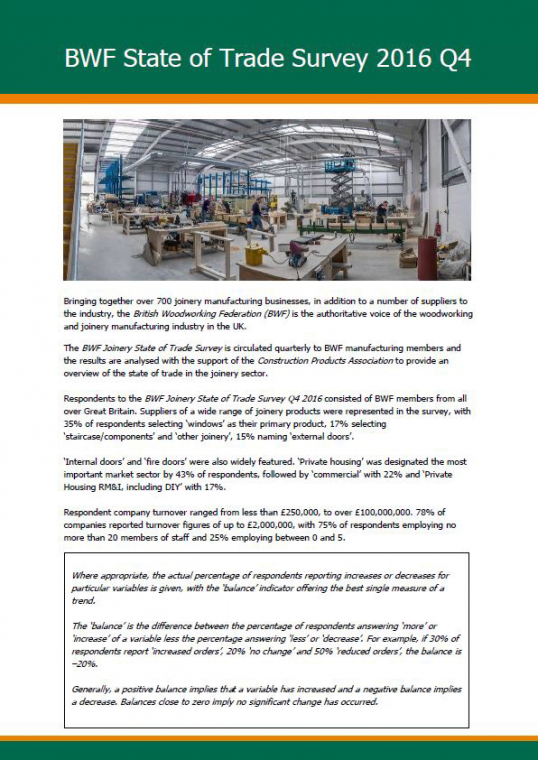The British Woodworking Federation’s Joinery State of Trade Survey has indicated that the benefits of increased joinery sales are being balanced out by inflationary pressures such as wages and the impact of exchange rates on raw material costs.
With business rates changes set to hit many joinery companies from April, the balance of respondents reported that rates for their current property would increase as a result of the recent revaluations, with almost one third expecting an increase of over 5%.

BWF policy and communications executive Matt Mahony comments on the state of the joinery industry and the business rates changes: “With the cost of doing business a concern for many in our sector, we surveyed what the consequences of the Business Rates Revaluations would be and were concerned to find that almost a third of respondents indicated an incoming business rates increase of over 5%.
“The high street may have been a major focus of the ‘business rates revolt’, but further cost rises for our industry are unpalatable.
“There are undoubtedly companies that will benefit from the changes, but on balance our industry looks to be getting a bad deal from the revaluations – this is especially galling as we have long campaigned for low energy manufacturers to be incentivised and it makes no sense to include plant and machinery in rateable value when trying to drive investment and job creation.
“Looking at the rest of the survey, on the whole we saw a stable, although by no means easy quarter for the woodworking industry. Sales volumes had increased by 26% on balance and were anticipated to grow again for the next quarter (Q1 2017), but at a lower growth rate than before.
“Further depreciations in the sterling also raised the cost of imported materials, meaning that raw materials continue to be the main driver of input price inflation, with wages and salaries also having a big impact on costs.
“Realistically it’s not a bad picture at this point of time, although uncertainty over the impact of Brexit continues to linger in the background as it has been for the last couple of quarters. You can see the impact on costs, but thankfully this doesn’t seem to have hit the investment intentions of joinery businesses or their plans to take on more staff.
“In the longer term the big questions are whether Government and industry can work effectively to deliver new plans for housing and manufacturing and also to what extent the market will be able to capitalise on Brexit. First the sector will have to get to grips with the major changes in training which could help address the availability of skilled labour and the issue of joiners having to provide a broader spread of services to fill main contractor skills gaps on site.”
Key points from the BWF Joinery State of Trade Survey Q4 2016 include:
– A balance of 20% of respondents reported that business rates for their current property would increase as a result of recent Business Rates Revaluations in England and Wales with 32% of respondents indicating that their rates would increase by over 5%.
– A balance of 26% of joinery companies reported an increase in sales volumes for Q4 2016 from the previous quarter. This follows on from 55% of joinery companies reporting an increase in sales volumes in Q3 2016 from Q2 2016.
– Manufacturers felt that sales volumes would improve in the next quarter, with a balance of 34% predicting an increase for Q1 2017, and a balance of 22% predicting an increase over the next year.
– 19% of companies reported a current order book of future work extending beyond three months – down 9% from the previous quarter – with 58% now saying that their order book extended from between one and three months.
– Demand was listed as the most likely constraint on output over the next year by 45% of respondents. Capacity and labour availability came next, with 21% and 18% of respondents feeling that they were most likely to constrain output. Raw material prices had become the main factor for 13%.
– 39% of respondents on balance reported increasing their labour force in the last year, with 57% of respondents anticipating an increase labour force over the next year.
– Raw material costs were noted as the main inflationary factor for unit costs for 87% of respondents, with wages/salaries increases pushing up unit costs for 81% of respondents on balance.
– Exchange rates were a factor in inflating unit costs for 57% of respondents – having risen from 5% a year previously.
– 67% of respondents on balance reported an inflationary impact in unit costs through fuel costs.
– Investment in product improvement had been increased by 50% of companies on balance over the past year, with a balance of 51% to boost investment over the next year.
– Investment in manufacturing equipment spending had been increased by 53% of companies on balance over the past year, with a balance of 66% to boost investment over the next year.
As a benefit of membership, BWF members can view the full survey plus the latest economic reports produced by the Construction Product Association industry forecasting team.











